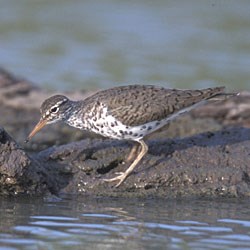
IntroductionA spotted sandpiper pair reverses the traditional roles found in most other bird species in a number of interesting ways. The female spotted sandpiper, for instance, migrates early to arrive at a potential nesting site before the male. She is the one that establishes the territory by driving other females away. After mating and laying her eggs, she abandons the the male who must then take on all of the parental duties of incubation and caring for the chicks. The female, freed from her parental duties, then seeks out and mates with one or more additional males, leaving each with a clutch of eggs. Nests are scrapes in bare soil lined with grasses usually close to water. Chicks are precocial, leaving the nest shortly after hatching and are capable of finding their own food, although the male still protects them. Like the killdeer, the spotted sandpiper male may lead predators away from the nest or young by using a "broken" wing distraction display. Look for spotted sandpipers along sandy or muddy shorelines within the Mississippi National River and Recreation Area. Fascinating Facts
Identification
| |
Last updated: March 16, 2022
